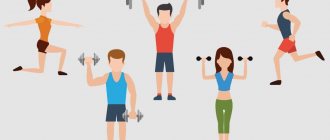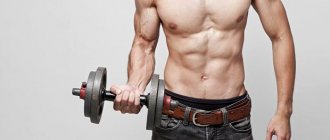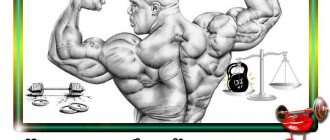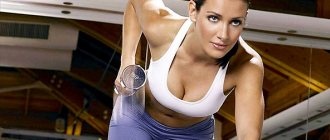Brief biography of Stanislav Lindover
Russian bodybuilder and champion Stanislav Aleksandrovich Lindover was born in 1972 in St. Petersburg, Russia. As a child, Stanislav was distinguished by a thin physique and poor health. However, Lindover was distinguished by boorish behavior and intemperance in behavior. After being diagnosed with rheumatic heart disease, the guy was released from physical education, Stanislav was only allowed to throw a ball.
In his teenage years, the boy enrolled in the javelin throwing section. And although Stanislav liked sports and practiced many times more than necessary, he did not achieve outstanding results. At the age of 17, Lindover became interested in bodybuilding and decided to try his hand at the gym. Soon the hobby grew into a lifelong endeavor.
After graduating from school, Lindover defended his diploma as a bridge construction engineer. However, the decision to connect his life with sports led to the fact that the athlete also graduated from the College of Fitness and Bodybuilding. Ben Weider in Moscow.
The future champion began his sports career as a sports club administrator. In 2006, Lindover appeared on the big stage for the first time. The first results were not outstanding, but the athlete continued training under the guidance of Andrei Pugachev.
As a child, Lindover suffered from a severe sore throat. Complicated streptococcal infection led to the development of rheumatism and heart disease. In 2008, as a result of a sports injury, the athlete suffered damage to the radial nerve. However, Stanislav did not give up and after a long rehabilitation returned to the sport.
In 2011, Lindover took part in the fight for the title of European champion and won the overall category. Over the next four years, the athlete mainly takes part in Russian competitions. In 2015, after several years of successful performances, the bodybuilder decides to devote himself entirely to coaching.
Training program
Lindover works out in the gym 5-6 days a week. Each lesson lasts from 2 to 5 hours. During training, he pays attention only to a certain muscle group. Stas Lindover's training is divided into cycles. For example, in one session he does lifting exercises, and in another he works on slow-twitch muscle fibers. Lindover recommends changing the order of exercises or even choosing similar ones to pump up a specific muscle group. This athlete pays great attention to the bench press in a lying position.
Training and nutrition
Vanity and pride are Lindover's main motivators. An athlete often looks for real and virtual opponents for himself and strives to surpass. Strict discipline is Stanislav’s main principle. The athlete develops a training program intuitively, but each individual day is devoted to one large muscle group. Lindover's approximate training schedule:
» Monday: chest segment » Tuesday: shoulders » Wednesday: back » Thursday: triceps » Friday: legs » Saturday: biceps » Sunday: stretching and microbuilding
Stanislav practices every day. Sometimes the number of athlete’s training sessions per day reaches 10-11. Even during individual sessions with clients, the athlete strives to demonstrate the exercise technique and perform sets as accurately as possible.
A bodybuilder carefully monitors his body mass index. To maintain shape, Lindover consumes large amounts of protein foods. The basis of the diet is fish, chicken and turkey. A third of your daily protein intake comes from protein shakes.
The athlete prefers buckwheat, brown rice and pearl barley as complex carbohydrates. Fats in Stanislav's diet are represented by olive oil and fish oil. Number of meals – 4, snacks – 2. For work trips, Lindover prepares portions in containers in advance.
Chest training with Lindover
MODES USED:
The mode is classic or medium-intensive, in which the exercise is performed for about 12 repetitions per set. Reps are not a valid marker and when it comes to 12 reps, that's the equivalent of about 25 seconds.
The rest time between working sets should be such that you can complete the next one without significantly reducing the number of repetitions in the approach, with the same weight. For example, in 1 working approach failure occurred at 12 repetitions, and in the next at 10-11.
A working approach is an approach to an apparatus in which an arbitrary failure occurs (the inability to perform another repetition technically correctly, with a given amplitude). In a mode in which the working range is approximately 12 repetitions, this is approximately 65-70% of the one-repetition maximum (1RM). 1RM can be approximately determined by knowing your working weight in this exercise for 6 reps to failure and adding 20% to it.
For example, you can bench press an 80kg barbell. for 6 reps. Thus, the 1RM maximum is approximately 95 kg, and for 12 repetitions - approximately 65 kg. In this mode, due to the high acidification of the cell with hydrogen ions, exercises within the training are performed alternately, i.e. first on one muscle group, and then on another.
Example: Bench Press.
The estimated working weight with which you must perform a given number of repetitions is 60 kilograms. The number of repetitions in the working approach(s) is 12. After joint warm-up:
We approach the apparatus and perform a barbell press with an empty bar for 15-20 repetitions. After resting for about 1 minute, increase the weight of the projectile to 30-35 kg. for 6-8 repetitions.
Then, after resting for about 1.5 minutes, we increase the weight of the projectile to 45-50 kg for 5-6 repetitions. After resting for about 1.5 minutes, we increase the weight of the projectile to 60 kg and perform the approach until complete failure. Then rest, which will allow you to perform the next approach with the same weight with approximately the same number of repetitions. Rest between working approaches can be 5-7 minutes.
The second mode is strength or high-intensity:
The workout is performed in the range of 6-8 repetitions. The pace of execution is normal, the range of movement is full, but without relaxing the target muscle group.
Exercises are performed mainly with free weights. The weight of the projectile is approximately 80-85% of 1RM. The rest time between working sets should be such that you can complete the next one without significantly reducing the number of repetitions in the approach, with the same weight.
Example. The estimated weight of the projectile in a working approach for 6-8 repetitions is 80 kg. After the joint warm-up, we approach the apparatus and perform a barbell press with an empty bar for 15-20 repetitions. After resting for about 1 minute, we increase the weight of the apparatus to 35-40 kg for 6-8 repetitions. Then, after resting for about 1.5 minutes, we increase the weight of the projectile to 55-60 kg for 5-6 repetitions. After a rest of about 1.5 minutes, we increase the weight of the projectile to 80 kg and perform the approach until complete failure and after rest, which allows recovery, the next working approach is performed (if it is provided for by the program).
Next, perform the following exercise on the same muscle group, because the degree of muscle fiber acidification with this number of repetitions is not significant. In this mode, exercises for one muscle group are performed sequentially, one after the other.
SPLIT for 3 days.
FIRST DAY.
The training takes place in the classic medium-intensive mode with 12 repetitions in two working approaches. The tempo of execution is normal (about 2 seconds per repetition), the amplitude of the movement is full, but without relaxing the target muscle group, i.e. in multi-joint exercises, do not straighten the limb (do not straighten the arm at the elbow, the leg at the knee).
Example. Bench press. The estimated working weight with which you must perform a given number of repetitions is 60 kilograms. The number of repetitions in the working approach(s) is 12. After the joint warm-up, we approach the apparatus and perform a barbell press with an empty bar for 15-20 repetitions. After resting for about 1 minute, increase the weight of the projectile to 30-35 kg. Then, after resting for about 1.5 minutes, we increase the weight of the projectile to 45-50 kg. After resting for about 1.5 minutes, we increase the weight of the projectile to 60 kg and perform the approach until complete failure.
Then rest, which will allow you to perform the next approach with the same weight with approximately the same number of repetitions. Rest between working approaches can be 5-7 minutes. Next, perform an exercise on the next muscle group.
BACK – TRICEPS – BICEPS.
Number of working approaches - 2
After the warm-up, follow the exercise: leg raises in a hanging position - 2 sets of 15 repetitions.
BACK. Exercise – wide-grip overhead pull-down.
TRICEPS. Exercise: push-ups with a narrow grip.
BICEPS. Exercise – standing barbell curl.
After the biceps exercise, rest for about 5-7 minutes before the next round.
BACK. Exercise – bent over row to the barbell belt.
TRICEPS. Exercise: close-grip barbell press.
BICEPS. Exercise - bending the arms while sitting with dumbbells at an angle.
CAVIAR. Exercise - raising on toes in the simulator.
CAVIAR. Exercise - raising on toes while sitting in a simulator.
SECOND DAY.
The training takes place in the classic medium-intensive mode with 12 repetitions in two working approaches. The execution is normal (about 2 seconds per repetition), the range of movement is full, but without relaxing the target muscle group, i.e. in multi-joint exercises, do not straighten the limb (do not straighten the arm at the elbow, the leg at the knee).
Example. Bench press. The estimated working weight with which you must perform a given number of repetitions is 60 kilograms. The number of repetitions in the working approach(s) is 12. After the joint warm-up, we approach the apparatus and perform a barbell press with an empty bar for 15-20 repetitions. After resting for about 1 minute, increase the weight of the projectile to 30-35 kg. Then, after resting for about 1.5 minutes, we increase the weight of the projectile to 45-50 kg. After resting for about 1.5 minutes, we increase the weight of the projectile to 60 kg and perform the approach until complete failure.
Then rest, which will allow you to perform the next approach with the same weight with approximately the same number of repetitions. Rest between working approaches can be 5-7 minutes. Next, perform an exercise on the next muscle group.
Photo by Stanislav Lindover
Stas Lindover how to remove excess fat
Bodybuilding star Stanislav Lindover told Khabarovsk athletes about the main rules of nutrition (PHOTO)
The famous bodybuilder Stanislav Lindover visited Khabarovsk for the first time. In the regional capital, he held an open seminar on the main rules of diet for bodybuilders, and also presented sports nutrition from a well-known company.
Master of Sports in bodybuilding, champion of Russia in 2014 and champion of Europe in 2011 in the classic bodybuilding category Stanislav Lindover told Khabarovsk athletes about the three components of a healthy diet: proteins, fats and carbohydrates. Two of these nutrients (biologically significant elements) must always remain constant.
About 1 gram of protein per kg of weight is necessary for the body to function normally. However, with this amount of protein, muscle building will not occur. 1 g of protein is the basic value and it needs to be increased: for women - by 05.0.6 g, for men - by 1 - 1.5 g. 2-2.5 grams per kg of weight is the optimal amount of protein for a bodybuilder.
- It's the same with fats. There is no need to try to remove all saturated fats - their deficiency will affect the hormonal system, which will also not allow muscle growth and can lead to hypoxia. 0.7-0.8 grams per kg of weight - this figure should remain unchanged. Fish oil, flaxseed, olive, cedar oils, in this case, are just what you need,” said Stanislav Lindover.
You can find a lot of information on the Internet about the amount of carbohydrates required for a bodybuilder. It is often said that in order to increase muscle size, you need to create a surplus of calories. But this is not true, says Stanislav Lindover and suggests that each athlete find his own amount of complex carbohydrates. Simple ones, in this case, “are not acceptable, since they do not give anything other than gastronomic sensations.” The experiment will take about a month, during which it is important not to change the nature of your training.
— Suppose a person works out 4 times a week and consumes 200 grams of carbohydrates - we weigh ourselves and add another 50 grams of carbohydrates. A week later, on the same day, we weigh ourselves again - most likely, the scales will show 500-600 grams “in the plus.” If the reflection in the mirror suits you, add another 50 grams of carbohydrates, the next week - another 50 grams. And so on until you notice unwanted changes in your body. Then remove the last 50-70 grams and get your ideal size. The amount of carbohydrates subsequently needs to be changed in proportion to the intensity of the training,” the athlete shared.
He also added that the last carbohydrate intake should be 1.5-2 hours before training. As for sports supplements and mineral-vitamin complexes, they should be used only against the backdrop of a properly structured basic diet.
Stanislav Lindover has been conducting seminars on sports diet throughout the country since last year. The main task is to explain the norms of proper nutrition and justify the rational use of supplements. Today the bodybuilder will hold a seminar in Vladivostok.
Evgenia Pustovit, Khabarovsk news on dvhab.ru
Source - Khabarovsk news on dvhab.ru
Interesting Facts
» Lindover competed in powerlifting competitions and bench pressed 190 kg.
» Favorite films: “The Last Samurai”, “Inception”. “Motto: “Do the same as everyone else, but better than everyone else.” » Stanislav’s first dumbbells are two tape recorders “Astra-209” and “Yauza”. » In 2020, the athlete was diagnosed with aortic valve disease. Lindover reconsidered his approach to training and developed a fitness program based on blood pressure and heart rate. » On the pre-competition diet, the athlete consumed up to 50 egg whites per week. “Lindover considers 2011 the most terrible year of his life, when his parents died, the athlete divorced his first wife and experienced a breakup with his daughter. Author: ForceMan from 20-12-2018, 21:52
- 0
How to lose weight correctly
I’ll say right away that this fat burning process consists of three phases. Very often you can hear that the number of fat cells in our body is predetermined at the genetic level. However, this is not the case, and in adipose tissues there are so-called preadipocytes. Once the fat cell is filled, the division process is activated. The worst thing about this is that the newly created fat cells cannot then be destroyed. Even if you undergo liposuction procedures, you must follow an appropriate diet and exercise afterwards. Otherwise, with the wrong lifestyle, fat cells will multiply and all the fat that was extracted from you will return. Of course, this will take time, but there is no doubt that this will happen. So, back to the first phase of the fat burning process.
The process of fat mobilization is called lipolysis, and it is activated by hormones such as norepinephrine and adrenaline. The maximum release of these substances is observed during physical activity. Moreover, it is not the working weight that plays an important role here, but the psycho-emotional state. Here I would like to note that many athletes pay great attention to working weights. In practice, this method of increasing the intensity of training is the most quickly exhausted.
It is important not just to increase the weight of the equipment, but to load the target muscles. When the weight of the weight is very large, you involuntarily use other muscles, and the effectiveness of the exercise decreases. It is also necessary to remember that excessive load has a negative effect on the joints. You go to the gym not for the sake of records, but to improve your health.
It is very important to first create a proper nutrition program. If you decide to lose weight, then the main enemy in this situation will be insulin. On the one hand, this hormone transports nutrients to muscle tissue, which leads to their hypertrophy. But it is also necessary to remember the concept of “insulin sensitivity of adipose tissues.” This parameter is determined by the number of corresponding receptors located on the surface of fat cell structures.
The main accumulation of receptors is observed in those parts of the body that we call problematic. In fact, it is this fact that explains why it is there that fat is deposited in the first place and at the same time is extremely reluctant to be disposed of. I recommend that you do not follow recommendations about the required amount of carbohydrates in your diet.
Conduct an experiment and determine at what amount of carbohydrates in the diet your body weight does not change. Based on this parameter, create a slight nutrient deficiency. When an energy deficit is created, the mobilization of fats from adipose tissues will begin. After this, it’s time to start the second phase of fat burning – oxidation. This process takes place in mitochondria, but fatty acids must still be delivered to them.
The transport substance in this situation is carnitine. Today you can find both rave reviews about this supplement and angry ones. No matter how you personally feel about carnitine, I can say that the supplement works, but only if you exercise. Liver cells produce this amine, but in small quantities. I recommend using l-carnitine in a single dosage of 2.5 grams. Once fatty acids are in the mitochondria, it is necessary to create certain conditions to activate the process of their oxidation. Cardio exercises will help you with this. So smoothly I brought you to the question of how to properly use aerobic exercise. There is one important point here that I want to draw your attention to. During cardio training, the body first uses glycogen as an energy source and only after that the process of fatty acid oxidation in mitochondria is activated.











